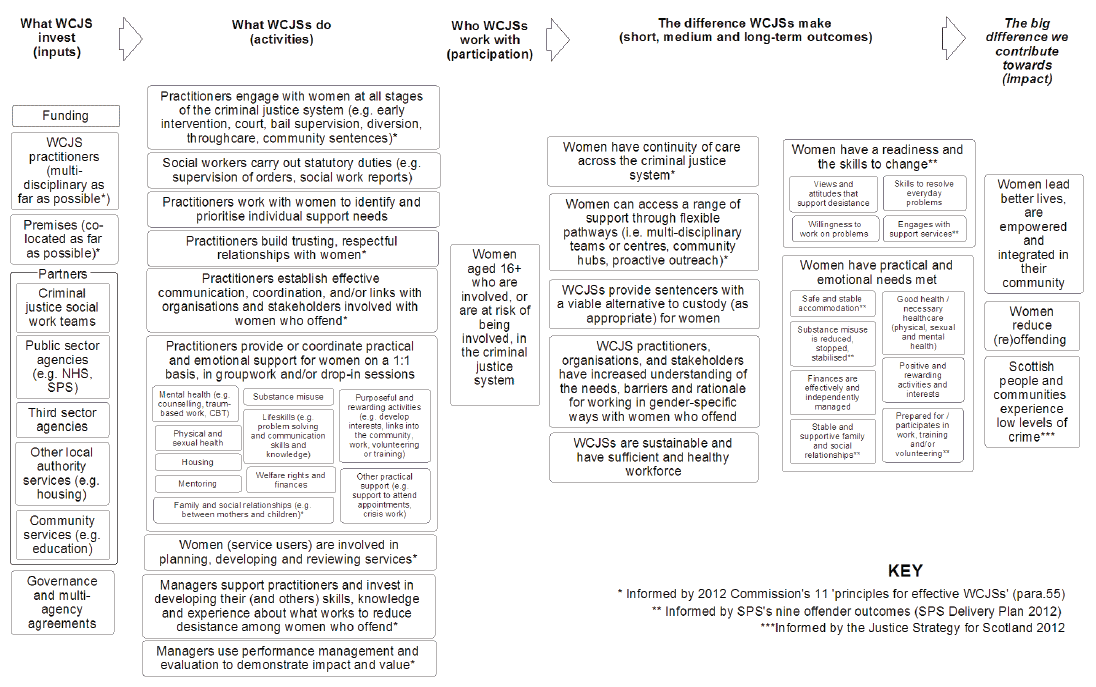Evaluation of Sixteen Women's Community Justice Services in Scotland
This document presents the findings of an evaluation of sixteen women’s community justice services in Scotland. The evaluation was conducted by the Institute for Research and Innovation in Social Services (IRISS) during 2014-15.
1 Introduction
1.1 This report presents findings from the national evaluation of 16 Women's Community Justice Services (WCJSs) undertaken on behalf of the Scottish Government in 2014/15.
1.2 In this report, 'women' is used to refer to service users in WCJSs (i.e. 'women offenders'). Real names are not used in quotes. Footnotes provide additional information to explain exceptions or provide context to numbers reported in the body of the text. Endnotes (using roman numerals) contain references to the literature. Boxes are used to highlight particular areas of interest or examples.
Background
1.3 In 2012, the Commission on Women Offenders Report (the 'Commission's Report') highlighted that many women in the criminal justice system have complex needs that relate to their social circumstances, previous histories of physical and sexual abuse, poor mental health, and substance misuse. Some of these needs are directly linked to these women's offending.[i]
1.4 The Commission's Report made a series of recommendations to 'improve outcomes for women in the justice system' (this evaluation focuses on the first three recommendations only). These included recommendations to establish local community justice centres, where multi-disciplinary teams from a range of agencies would co-locate and co-ordinate holistic support.
1.5 As part of the response to these recommendations, the Scottish Government allocated just over £3m of time-limited funding in 2013/14 and 2014/15 to 16 projects proposed by local criminal justice partners across Scotland to develop, extend or restructure their delivery of support to women offenders.[5] Partners were expected to sustain these changes themselves beyond the expiry of the funding in March 2015 through a reconfiguration of existing resources.
National Logic Model
1.6 The national logic model illustrates how WCJSs were originally envisaged to contribute to positive outcomes for women and reduce reoffending (Figure 1). WCJSs varied in their focus on different components of service delivery. The logic model provided a structure for the evaluation questions (see section 2.2 and Annex A).
1.7 The national model was informed by WCJSs' local logic models,[6] and the Commission's Report's aspirations for WCJSs,[i] and it made links to the Scottish Prison Service's 'nine offender outcomes'[ii] and Scotland's Justice Strategy 2012.[iii]
1.8 The theory of change presented in Annex B describes the logic model in narrative form (see Annex B). It explains that, within its unique local context, each WCJS will use available resources (e.g. practitioners and premises) to carry out a range of activities (e.g. supervision, holistic support, build links with partner agencies) for women in their specific target group. This is intended to lead to women having access to holistic support at all stages of their journey through the justice system, which in turn should contribute towards changes in women's lives in the short and medium term (e.g. readiness to change, practical and emotional needs are met). WCJSs are then expected to contribute towards long-term outcomes (e.g. women lead better lives, reduce their offending and reintegrate into their communities).
1.9 The theory of change is informed by assumptions about the conditions under which WCJSs existed (Annex B), including that interventions were evidence based and reached those they were intended for. The assessment of the extent to which these assumptions occurred in practice helped the evaluation to identify reasons why outcomes were achieved or not.
Figure 1: National logic model of Women's Community Justice Services

Contact
Email: Tamsyn Wilson
There is a problem
Thanks for your feedback